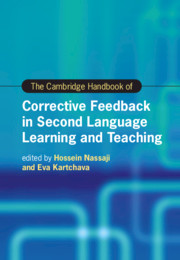Book contents
- The Cambridge Handbook of Corrective Feedback in Second Language Learning and Teaching
- Cambridge Handbooks in Language and Linguistics
- The Cambridge Handbook of Corrective Feedback in Second Language Learning and Teaching
- Copyright page
- Contents
- Figures
- Tables
- Contributors
- Acknowledgments
- Introduction Corrective Feedback in Second Language Teaching and Learning
- Part I Theoretical Perspectives on Corrective Feedback
- Part II Methodological Approaches in the Study of Corrective Feedback
- Part III Different Delivery Modes of Corrective Feedback
- Part IV Feedback Provider, Feedback Intensity, and Feedback Timing
- 13 Peer Feedback in Second Language Oral Interaction
- 14 Focused versus Unfocused Corrective Feedback
- 15 Corrective Feedback Timing and Second Language Grammatical Development: Research, Theory, and Practice
- 16 Explicit and Implicit Oral Corrective Feedback
- Part V Corrective Feedback and Language Skills
- Part VI Contexts of Corrective Feedback and Their Effects
- Part VII Learners’ and Teachers’ Feedback Perspectives, Perceptions, and Preferences
- Part VIII Individual Differences, Tasks, and Other Language- and Learner-Related Factors
- Index
- References
15 - Corrective Feedback Timing and Second Language Grammatical Development: Research, Theory, and Practice
from Part IV - Feedback Provider, Feedback Intensity, and Feedback Timing
Published online by Cambridge University Press: 26 February 2021
- The Cambridge Handbook of Corrective Feedback in Second Language Learning and Teaching
- Cambridge Handbooks in Language and Linguistics
- The Cambridge Handbook of Corrective Feedback in Second Language Learning and Teaching
- Copyright page
- Contents
- Figures
- Tables
- Contributors
- Acknowledgments
- Introduction Corrective Feedback in Second Language Teaching and Learning
- Part I Theoretical Perspectives on Corrective Feedback
- Part II Methodological Approaches in the Study of Corrective Feedback
- Part III Different Delivery Modes of Corrective Feedback
- Part IV Feedback Provider, Feedback Intensity, and Feedback Timing
- 13 Peer Feedback in Second Language Oral Interaction
- 14 Focused versus Unfocused Corrective Feedback
- 15 Corrective Feedback Timing and Second Language Grammatical Development: Research, Theory, and Practice
- 16 Explicit and Implicit Oral Corrective Feedback
- Part V Corrective Feedback and Language Skills
- Part VI Contexts of Corrective Feedback and Their Effects
- Part VII Learners’ and Teachers’ Feedback Perspectives, Perceptions, and Preferences
- Part VIII Individual Differences, Tasks, and Other Language- and Learner-Related Factors
- Index
- References
Summary
This chapter summarizes research on the timing of written and oral corrective feedback (CF) on L2 grammatical errors. A careful analysis of a comprehensive array of CF timing studies indicates that there are learning benefits from both immediate and delayed CF. The analysis also demonstrates the need for more uniform construct definitions and more rigidly designed studies in the area of CF timing research. The chapter then explains several theoretical proposals about how immediate and delayed CF facilitate L2 development. These proposed explanations include sociocultural theory, Transfer Appropriate Processing, skill acquisition theory, and cognitive comparison via reactivation and reconsolidation. In addition, this chapter discusses the potential implications that research and theory might have for L2 pedagogy, concluding that at this juncture, the literature provides teachers with justifications for using both immediate and delayed CF. Finally, the chapter ends with recommendations about what future research might best be conducted in the area of CF timing.
Keywords
- Type
- Chapter
- Information
- The Cambridge Handbook of Corrective Feedback in Second Language Learning and Teaching , pp. 322 - 340Publisher: Cambridge University PressPrint publication year: 2021
References
- 5
- Cited by

